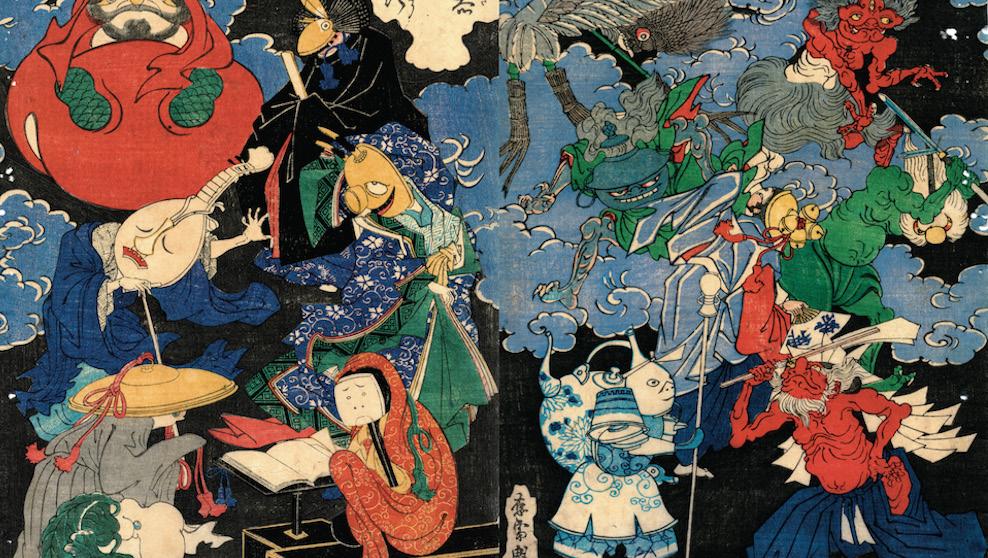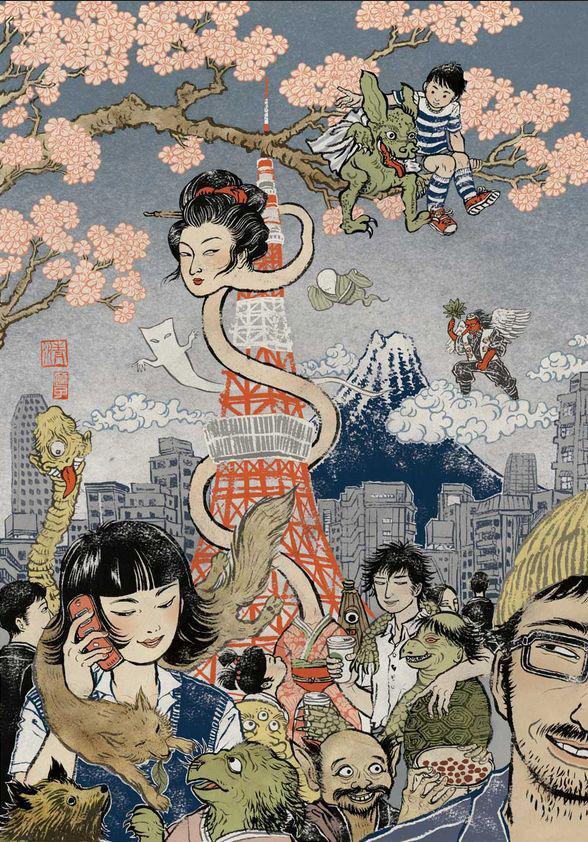
6 minute read
A Tour of a Japanese
A Tour of a Japanese Mystery World: Yokai
Jenny Yuan
Advertisement
Edited by Josephine Man Designed by Am Chunnananda
It was an empty room with only a couple of traditional Japanese dolls sitting on the shelf. I stared at the dolls out of boredom: they had chubby faces, dainty eyes, and ruby-like mouths. I grew tired and decided to lie down. That was when I recognized the faded blood stains on the floor. Then I heard childlike giggles behind my back…
Luckily that was just a dream after I watched one episode about Zashikiwarashi, a childlike Yokai, in ayakashi. It was truly a spooky story, but somehow I got fascinated by the Yokai character and their stories after watching it.
Having spent most of my time in Asia growing up, my childhood was greatly impacted by Japanese media such as movies, anime, and TV shows. From 怪 ayakashi, Natsume’s Book of Friends, to the classic Ghibli movie Spirited Away, or famous fiction Onmyōji (陰陽師), Yokai were one of the most popular elements in Japanese pop culture. Yokai, which means monsters or spirits in Japanese, were intended to spook people in the ancient days. Interestingly, in modern pop culture, they don’t always appear as spooky or evil characters. More often, they are depicted as an adorable character. In the anime Kappa no Kaikata, Kappa (a spirit that lives in a river) appears as a chubby, short boy with a beak who is being kept by a human as a pet. These interesting depictions got me fascinated about the Yokai culture and started my exploration of the artistic and cultural background behind it.
Yokai, written as 妖怪, could translate as ghost, spirit, or monster. More precisely, the character 妖 means bewitching and 怪 means mysterious. In Japanese culture, yokai can appear in many different forms: human, animal, or even natural phenomena. The appearance of the Yokai changes based upon the perception of the artist. Most of the images of Yokai we can see today are from the Edo period (1603 and 1868 ), and in the form of ukiyo-e. In the early 1600s, during the power transfer from emperors to shoguns, the Japanese merchant class became wealthier, which enabled them to spend money on fleeting pleasures known as ‘ukiyo’, or the “floating world.” The -e at the end of ‘ukiyo-e’ means drawing in Japanese. Then, a style of print marketed to the merchants started to bloom in Japanese culture. The technique of woodblock printmaking first originated in China and arrived in Japan during the 6th century. The process of producing ukiyo-e usually involved four people: an artist who designs the drawing, a woodcarver, a printer who colors it and presses it, and a publisher who sells it. One of the most famous yokai ukiyo-e is the “Takiyasha the Witch and the Skeleton Spectre,” drawn by Utagawa Kuniyoshi in the 19th century.


Takiyasha the Witch and the Skeleton Spectre by Utagawa Kuniyoshi and Santō Kyōden
The drawing depicts the scene of a woman using spells to call out a monstrous skeleton to fight two warriors. The woman is Princess Takiyasha who is also the daughter of Taira Masakado— the man who started a rebellion against the court in Kyoto. When the rebellion failed, her father was killed and the ghost of the soldiers still haunted Masakado’s palace. Thus, she vengefully summons the ghosts into an enormous skeleton to fight with the warrior, Ôya Tarô Mitsukuni, who was sent by the emperor to hunt down the allies of Masakado.

Examples of various yokai

There are a plethora of stories that feature Yokai in Japanese culture, and these interesting stories are recorded in the form of folklore, drawings, or books:
Bakezōri (化け草履)
Bakezōri (化け草履) are yokai transformed from the traditional straw sandals spirit. They sprout arms and legs from the body and have a large single eye in the middle of the body. According to Japanese folklore, Bakezōri were shoes that were neglected or lost by their owner for a long time that eventually developed their own consciousness. They are said to be harmless but may pester humans when they feel bored or frustrated.
Kasa-Obake (傘おばけ)
Kasa-Obake (傘おばけ), the umbrella ghost, is one of my favorite yokai. In the anime Yamishibai, there is a classic episode about it, which is both scary and fascinating. This yokai used to be an old umbrella that was neglected. It has only one eye, jumps around using the handle as a leg, and sometimes is depicted to have a long tongue
Makuwauri no bakemono (真桑瓜の化物)
Makuwauri no bakemono (真桑 瓜の化物) is the yokai with the funniest appearance. It is usually an oriental melon (Cucumis melo) with the body sprouting from it. According to folklore, this yokai comes from the river ferry in a village which is famous for its melon from Kyōto. However, the specific origin story is lost.
Ittan-Momen (一反木綿)
Ittan-Momen (一反木綿) is a long sheet of cloth yokai. This yokai is usually depicted as white, long narrow sheets of cloth. They normally fly at night, attacking people by wrapping their bodies around a person’s face and neck. With their mighty strength and ability to mercilessly smother people to death through suffocation, this yokai is dangerous and deadly.

Enenra (煙々羅)
Enenra (煙々羅) is a yokai made up of smoke. They usually appear around smoke, chimneys, and bonfires. As the smoke rises, human-like faces show in the smoke. They float and appear as a fragile silk dancing in the air. It is said that they sometimes take human form and could only be seen by the pure of heart.

Ittan-Momen is the white ghost-like creature in the left side of the tower. The Kasa-Obake is the umbrella with one eye right before the tower.
Nowadays, Yokai culture inspires so many characters in movies, visual arts, games, and literature. The Exeggutor, from the popular video game Pokémon, is a palm tree character who has three to six faces. It was based on Jinmenju, a Yokai first depicted on paper in 1712.
Yokai culture not only made an influence in Japan, but also on Western pop culture. If you are a fan of Harry Potter, you may notice that a Kappa, a Yokai that lives in shallow ponds, appears in the movie Harry Potter and the Prisoner of Azkaban and Fantastic Beasts: The Crimes of Grindelwald. It is interesting to see that a large portion of modern pop culture is deeply rooted in Japanese culture and history. Yokai in Japanese folklore originated from everyday objects and natural phenomena. Much of yokai-based Japanese folklore is rooted in the ancient Japanese religion of Shintoism, a religion believes that everything has a spirit and deserves reverence. The masterpieces that depict yokai reveal its ambiguous and mysterious allegories, symbolizing the aspect of Shintoism that connects supernatural fear, awe, and reverence of nature with the earthly being and human daily life.


Different Pokémon, stylistically illustrated










